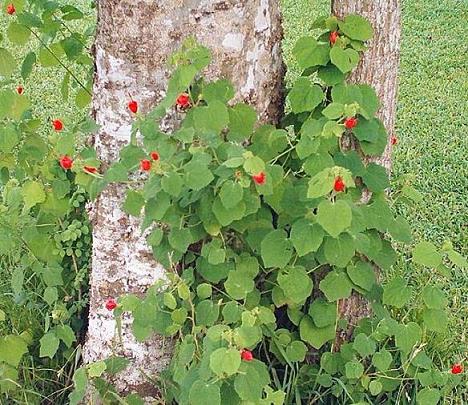Turk's Caps
on Friday, June, 07 2013 07:02:39 pm , 557 words
Categories: Uncategorized , 44658 views

Photo © R. H. Livingston
If you're a Texas gardener who has been frustrated by extremes in weather conditions, especially the nearly-year-long drought of 2011, a native flowering plant may be just what you are looking for to add beautiful foliage and color to your flower gardens. The Turk's Cap (Malvaviscus arboreus var. drummondii) is a hardy, drought-resistant, spreading herbaceous perennial shrub that produces a profusion of beautiful red blooms (though white blooming plants are sometimes found) that open in an attractive swirled pattern that has been likened by some gardeners to a showy middle-eastern-style headdress. Besides its variety name, drummondii, the plant is known by a number of popular names, such as Bleeding Heart, Sleeping Hibiscus, Drummond Wax Mallow, Red Mallow, Texas Mallow, May Apple, and Mexican Apple.
The Turk's Cap is a member of the hybiscus family of plants (also called the mallow family, which also include plants such as marshmallow, okra, cotton, and cacao).
The Turk's Cap variety native to Texas is named for and was first collected by naturalist Thomas Drummond, who was born in Scotland around 1790 and died in Havana, Cuba, in March of 1835 following twenty-one months spent in Texas (he arrived at Velasco at the mouth of the Brazos River in March of 1833), during which he collected 750 species of plants and 150 species of birds.
Native to the southernmost states, from Texas to Florida, the Turk's Cap, besides its heat tolerance, is also quite adaptable to a range of soil ph and fertility levels. In USDA hardiness zones 7 to 11 the plant is perennial but in zones 6 and north the plants are best grown as annuals.
Generally the hardy Turk's Cap grows as wide as it is tall (usually two to three feet, although stems can sometimes reach to nine feet in length). The Turk's Cap loves shade and is thus perfect for such sometimes problematic areas of gardens. (The plants can grow in any location favorable to shrimp plants, for example.) Turk's Caps also grow well in direct sunlight; however, in such situations they are subject to mildew damage.
Turk's Caps bloom from May to November. Though generally red-bloomed in their natural habitat, white-bloomed cultivars of Turk's Cap have been produced. Cross breeding the native Texas variety (drummondii) with varieties from elsewhere has in recent years produced some spectacular variations in bloom sizes and color. The Turk's Cap bloom never fully opens but unfolds in such a way that the inner edges form a tube through which protrudes the lengthy stamen.
It can be difficult to transplant Turk's Cap plants due to their deep and widespread roots system, so it is best to transplant late in the autumn or early in the spring and to water a plant well during its first year in its new location, after which the plant can pretty much tolerate dry conditions quite well. The plants can easily be grown from seed, which can be obtained in the fall from the marble-sized red fruits which resemble tiny apples, hence the popular names May Apple and Mexican Apple.
Though mostly grown for its beautiful, colorful and unusual blooms and medium to dark green, luxuriant foliage, the Turk's Cap provides a sought-after nectar for hummingbirds and butterflies. The red, marble-sized fruits are also a favored food source for many species of wildlife.
Photo © Justen Williams

